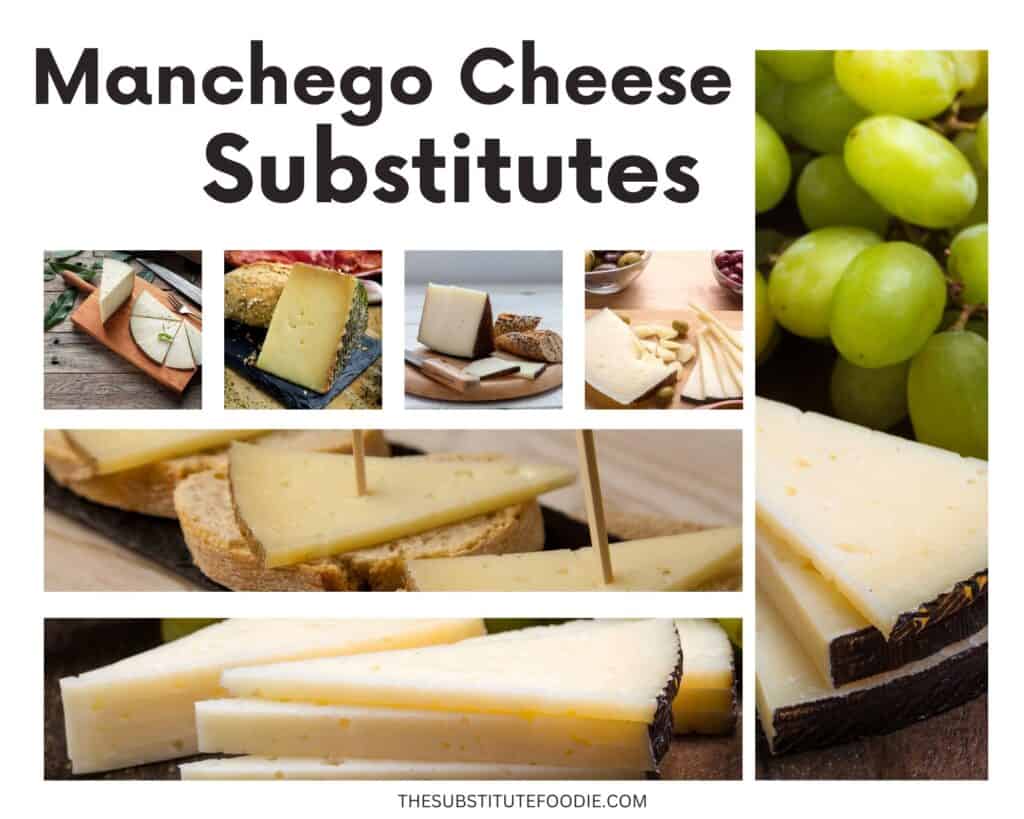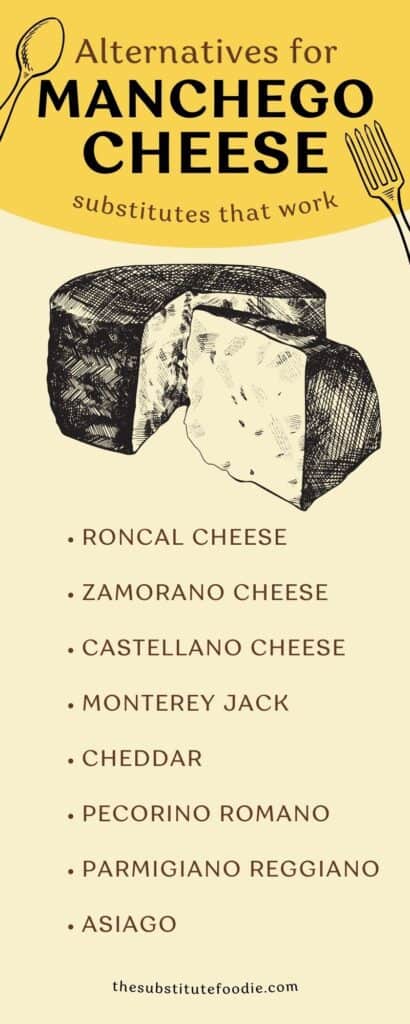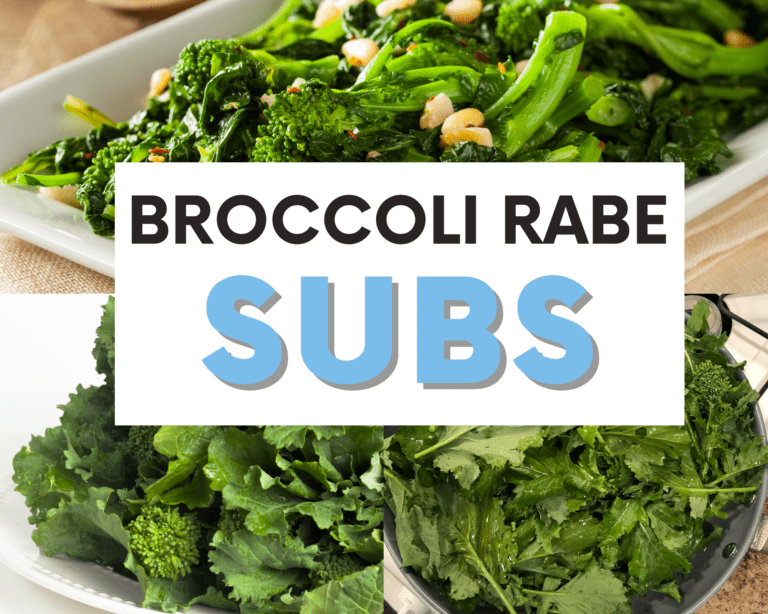The BEST Manchego Cheese Substitutes You Gotta Try
This post may contain affiliate links. Please see my disclosure policy for details.
Do you want to make a classic recipe that calls for Manchego cheese but can’t find any in your area? Or the price scares you. Well, you’re not alone! While many love the creamy and nutty flavor of this Spanish sheep’s milk cheese, it can be not easy to find, or your store is out. But don’t despair – you have options when looking for Manchego cheese substitutes.
Several convenient replacements for Manchego cheese have very similar flavors and textures, allowing you to enjoy your favorite dishes still. In this blog post, we will provide tips and tricks on getting a good Manchego substitution so that you can whip up delicious meals from the comfort of your home.
But like I do with most of my posts, I like to share the taste and flavor of what we are trying to find a replacement for. If we can grasp all the wonderfulness of manchego, then perhaps we can find another cheese that is similar.
What Does Manchego Cheese Taste?
Manchego cheese is a semi-firm to hard cheese made from sheep milk. It originated in the La Mancha region of Spain and has become one of the country’s most beloved cheeses. With its slightly crumbly texture and buttery flavor, Manchego is perfect for slicing and pairing with Spanish dishes like Rioja-braised lamb or Serrano ham.
It boasts unique flavors such as mildly nutty, sheepy tones fused with a gentle tang that lingers on the palette. Not too salty but slightly sweet and creamy, this Spanish specialty will undoubtedly leave a lasting impression. It’s downright delicious!

The BEST Substitutes for Manchego Cheese
All these manchego cheese alternatives are a 1-to-1 ratio.
Roncal Cheese
Roncal Cheese is a close substitute for manchego cheese. It’s a cow’s milk cheese named after a small village of the same name in Navarra, Spain. It has a characteristic coarse texture with small eyes, and its flavor is unique; it is neither pungent nor sweet but balanced and harmonious. Some describe it as having an olive-like nuttiness. The aging process takes approximately six months and produces an intense flavor that pairs perfectly with toasted bread or liqueur-and-honey competes.
Zamorano Cheese
Zamorano cheese is produced in the Zamora region of Spain, using traditional techniques and raw sheep’s milk. It has a distinctively sweet, creamy, and tangy flavor, with a slightly smokey aftertaste. The texture is semi-hard and crumbly, making it a perfect ingredient for dishes such as tacos or quesadillas. It’s also an excellent addition to any cheese platter and pairs wonderfully with jam or honey-based accompaniments.
Castellano Cheese
Castellano cheese is a unique Spanish cheese with a hard texture and a rich buttery flavor. The savory taste is derived from the quality grade of the milk used in the production process, which combines sheep, goat, and even cow’s milk. Due to the diverse range of milks that are used, Castellano cheeses have a distinctive hint of hazelnut and a slightly sour palate. Its most notable feature is its slightly salty aftertaste that lingers on the tongue. All in all, Castellano cheese has an intense yet smooth flavor that excites every taste bud one bite at a time!
Monterey Jack
Monterey Jack is a semi-firm cow’s milk cheese that originated in California. It has been produced since the 1700s, and some believe it’s named after David Jack, an early Monterey pioneer. Monterey Jack has a mild flavor with nuances of butter and nuts, and it is slightly salty with a slightly sweet finish. Its texture is fairly firm but creamy when melted.
Monterey Jack takes on different flavors very well, so it is often seasoned or smoked for unique flavors. It also melts easily compared to other cheeses, making it ideal for use in Mexican dishes like tacos and quesadillas or as a topping on bread and pizzas.
Cheddar
Cheddar is a cheese with a unique flavor profile; its taste is described as tangy and nutty, with an intense sharpness. Although tastes vary from region to region, and even from batch to batch depending on the type of milk used in production, cheddar generally has an umami-like quality that lends itself to pairing with fruit and wine.
As cheddar ages, it develops a stronger flavor thanks to the natural enzymatic breakdown of proteins and fats over time – hence why vintage cheddars have such a signature taste compared to their younger counterparts. When swapping for manchego, go for a mild cheddar and avoid the sharp ones.
Pecorino Romano
If you need an aged Manchego cheese substitute, then Pecorino Romano is one that works well. It is a hard, salty cheese with origins in ancient Rome. Its flavor profile is unmistakable and distinct. Its sharp taste and tanginess come from the salt content used both during production and for preservation.
The cheese also has a slight nuttiness from its aging process of at least five months. It can be served as a table cheese or grated over dishes such as pasta, soups, or salads – where its strong flavors will add complexity to the dish. Although Pecorino Romano has an acquired taste due to its saltiness, it is certainly worth trying for those looking for a unique and flavorful addition to their cooking.
This substitute works great for when your recipe needs grated manchego.
Parmigiano Reggiano
Another great aged Manchego alternative is Parmigiano Reggiano. It is a hard Italian cheese often referred to as the “King of Cheese” due to its rich, complex flavor profile. Aged for a minimum of 12 months, the cheese has a nutty, slightly salty taste and granular texture. It is a key ingredient in many Italian dishes and can be used both in cooked and raw preparations, including pasta, salads, and antipasto platters. Parmigiano Reggiano can also be enjoyed on its own with some cured meats and crusty bread for a complete Italian meal experience.
Like Romano cheese, Parmigiano Reggiano works great as a substitute for manchego when you need the grated form.
Asiago
Asiago cheese has a flavor that can be described as nutty and sweet, with an aroma similar to that of butter. It’s a hard, semi-aged cheese that grows more pungent in taste as it ages. The most common variety of Asiago is usually sold in two distinct types; a younger version known as Asiago Pressato and the mature version known as Asiago d’allevo. Pressato features a softer texture and milder flavor, while d’Allevo offers a harder texture with strong flavor notes. Depending on what recipe it’s used in, the variety chosen can definitely affect the overall taste. Asiago pairs extremely well with lighter beers or crisp whites, which helps bring out its nutty undertones.

My Final Thoughts on Manchego Cheese Substitutes
Manchego cheese is a versatile, flavorful cheese that can be used in many different dishes. If you don’t have Manchego cheese on hand, there are several substitutes that will work just as well. Roncal cheese, Zamorano cheese, Castellano cheese, and Pecorino Romano are all excellent choices. So next time you’re looking for a Manchego substitute, give one of these cheeses a try. I’m sure you’ll find the perfect flavor to complement your dish. Happy cooking!






